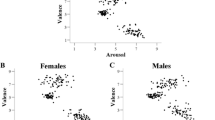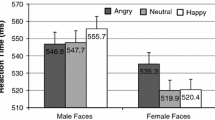Abstract
Male and female encoding-decoding of spontaneous and enacted nonverbal affective behavior was evaluated using the Buck (1977) slide-viewing paradigm. The eliciting stimuli were carefully selected and evaluated to insure a comparable emotional impact on both sexes, and all subjects received the same decoding task. Consistent with previous research, females were superior decoders overall. Also as predicted, females were superior encoders, principally when reacting spontaneously to the slides. Given no evidence of differential affective arousal, this sex difference for spontaneous encoding is interpreted to reflect differences in male-female display rules. Contrary to several previous findings spontaneous and enacted encoding measures were not strongly related, especially for males, where display rules may modify their spontaneous and enacted expressive behavior in comparison to females. There was no consistent positive or negative relationship between dimensional or category measures of encoding-decoding for either sex. Future investigations should separately evaluate encoding-decoding phenomena for each sex, employing more precise methods to evaluate the specific nonverbal behaviors actually important to the encoding-decoding communication process.
Similar content being viewed by others
References
Buck, R., Miller, R. E., & Caul, W. F. Sex, personality, and physiological variables in the communication of affect via facial expression.Journal of Personality and Social Psychology, 1974,30, 587–596.
Buck, R., Slavin, V. J., Miller, R. E., & Caul, W. F. Communication of facial affect through facial expressions in humans.Journal of Personality and Social Psychology, 1972,23, 362–371.
Cunningham, M. R. Personality and the structure of the nonverbal communication of emotion.Journal of Personality, 1977,45, 564–584.
Cupchik, G. C. Expression and impression: The decoding of nonverbal affect. (Doctoral dissertation, University of Wisconsin, 1972.)Dissertation Abstracts International, 1973,33, 5536B.
Ekman, P. Universals and cultural differences in facial expressions of emotion.Nebraska Symposium on Motivation, 1972,19, 207–283.
Ekman, P., & Friesen, W. V.The facial action coding system. Palo Alto, Calif.: Consulting Psychologists Press, 1978.
Ekman, P., Friesen, W. V., & Ellsworth, P. E.Emotion in the human face. Elmsford, N.Y.: Pergamon, 1972.
Ekman, P., & Oster, H. Facial expressions of emotion.Annual Review of Psychology, 1979,30, 527–554.
Harper, R. G., Wiens, A. N., & Matarazzo, J. D. The relationship between encoding-decoding nonverbal emotional cues.Semiotica, 1979,28, 171–192.
Lanzetta, J. T., & Kleck, R. E. Encoding and decoding of nonverbal affects in humans.Journal of Personality and Social Psychology, 1970,16, 12–19.
McNemar, Q.Psychological statistics. New York: Wiley, 1962.
Newtson, D. Foundations of attribution: The unit of perception of ongoing behavior. In J. Harvery, W. Ickes, & R. Kidd (Eds.),New directions in attribution research. Hillsdale, N. J.: Erlbaum, 1976.
Snyder, M. Self-monitoring of expressive behavior.Journal of Personality and Social Psychology, 1974,30, 526–537.
Zaidel, S. F., & Mehrabian, A. The ability to communicate and infer positive and negative attitudes facially and vocally.Journal of Experimental Research in Personality, 1969,3, 233–241.
Zuckerman, M., Hall, J. A., DeFrank, R. S., & Rosenthal, R. Encoding and decoding of spontaneous and posed emotional expression.Journal of Personality and Social Psychology, 1976,34, 966–977.
Zuckerman, M., Lipets, M. S., Koivumaki, J. H., & Rosenthal, R. Encoding and decoding nonverbal cues of emotion.Journal of Personality and Social Psychology, 1975,32, 1068–76.
Reference Notes
Buck, R.The slide viewing paradigm in the measurement of nonverbal communication. Paper presented at the American Psychological Association Convention, San Francisco, August 1977.
Harper, R. G., Wiens, A. N., & Fujita, B. N.Individual differences in encoding-decoding of emotional expression and emotional dissimulation. Paper presented at the American Psychological Association Convention, San Francisco, August 1977.
Hall, J. A.Gender, gender roles, and nonverbal communication skills. Paper presented at the American Psychological Association Convention, Toronto, August 1978.
Buck, R.Spontaneous nonverbal behavior in the study of emotion: problems and prospects. Paper presented at the American Psychological Association Convention, Toronto, August 1978.
Zuckerman, M., & Larrance, D. T.Individual differences in perceived encoding and decoding abilities. Paper presented at American Psychological Association Convention, Toronto, August 1978.
Author information
Authors and Affiliations
Additional information
This article is based on portions of a doctoral dissertation completed by the first author at the University of Washington. Appreciation is expressed to Ross Buck and Paul Ekman for their helpful comments and suggestions on the manuscript.
Rights and permissions
About this article
Cite this article
Fujita, B.N., Harper, R.G. & Wiens, A.N. Encoding-decoding of nonverbal emotional messages: Sex differences in spontaneous and enacted expressions. J Nonverbal Behav 4, 131–145 (1980). https://doi.org/10.1007/BF00986815
Issue Date:
DOI: https://doi.org/10.1007/BF00986815




